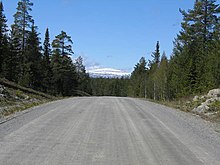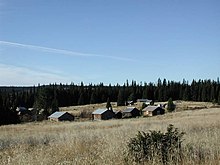Fäbodvägen
The Fäbodvägen is a tourist route in the southern part of the Oviksfjällen in the Swedish province of County of Jämtland . It leads from the village of Börtnan in the south to Persåsen in the north.
There are around 30 alpine settlements, some of which are cultivated, along this road, which runs through coniferous and birch forests close to the mountains, mountains and wide moor areas. The practically uninhabited area between the southern Storsjö region and Oviksfjällen was of great importance as a hinterland for local farmers until the 20th century. Here there was access to rich forest and mountain pastures as well as productive swamp pasture areas. The traces of the alpine farming are visible over decades, as the open pastures around the alpine pastures only overgrow extremely slowly. Cultivated plants such as B. the narrow-leaved willowherb , marsh marigolds and raspberry bushes can be found regularly on older alpine pastures.
Fäbodvägen was laid out as a passable road in 1964/1965. Previously, the Ovik farmers drove their cows every year in the summer months from June to August on simple paths that connected the alpine pastures to the mountain meadows. Between these and the villages there was a well-developed network of paths and trails, many of which are now used as hiking trails.
The best-known alpine pastures that operate alpine pastures in summer are Östra Arådalen and Långbodarna. There are overnight accommodations in the alpine huts in Långbodarna and in Galåbodarna . Other more important alpine pastures along the Fäbodvägen, seen from Börtnan to Persåsen: Västra Galåbodarna, Svedjebodarna, Fittjebodarna and Landsombodarna as well as Nybodarna, Valskaftet, Prästbodarna and Västra Arådalen along or near the road to Arådalen and Glen .
The alpine settlements have been preserved to varying degrees. On some alpine pastures almost all of the original buildings have been preserved, while on others only foundation walls and cellar pits can be seen. Others have been converted and are used as holiday homes. Typical of the alpine settlements is the large number of small, unpainted log houses, with each house having its own function.
Three nature reserves border on Fäbodvägen , which are also part of the Europe-wide Natura 2000 network. These are (from east to west) Marntallsåsen's nature reserve, Brötarnas nature reserve and Arådalen's nature reserve . Here are v. a. the western taiga spruce forest, species-rich sedges -grass landscapes, swamps and moors (aapamoore) and the mountain birch forest are protected. The lynx and wolverine are on the list of mammals worthy of protection . The partly open moors, partly overgrown with old pines, in the Brötarnas nature reserve serve numerous birds as nesting and hunting grounds. These include As star and Slavonian grebe , the Harrier , Merlin , short-eared owl and boreal owl and hazel , capercaillie and black grouse .


